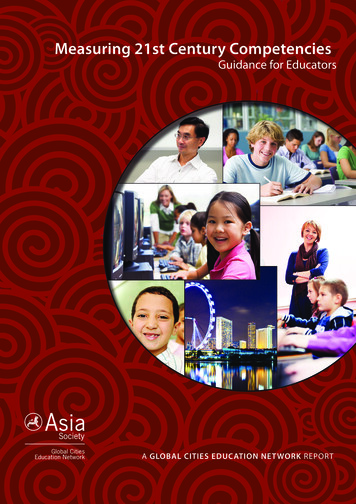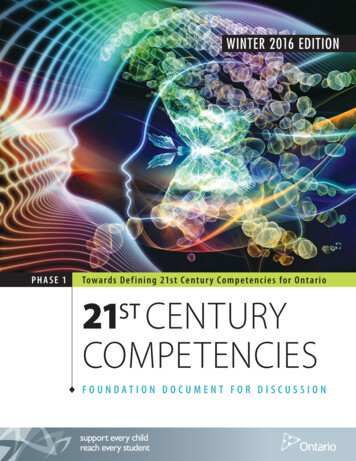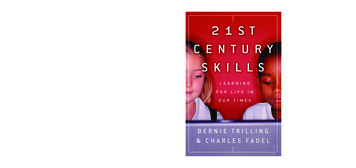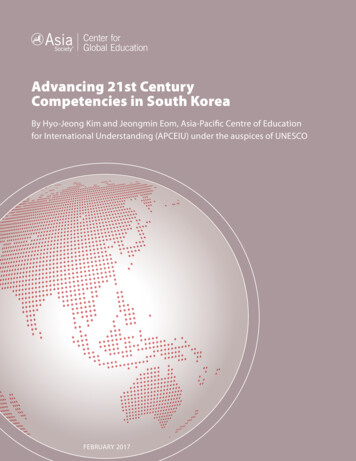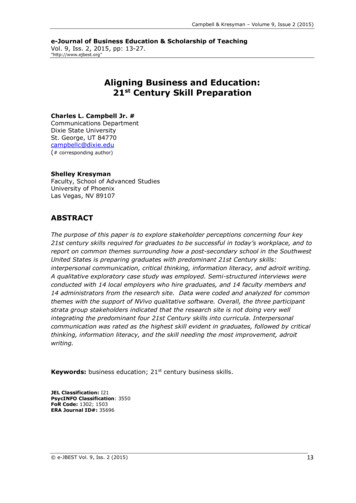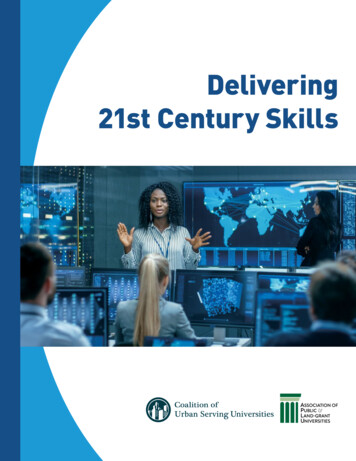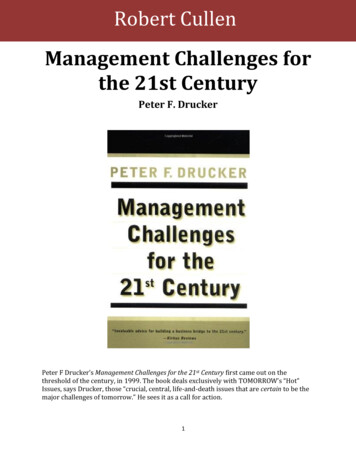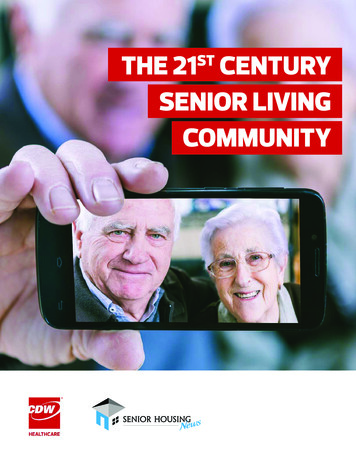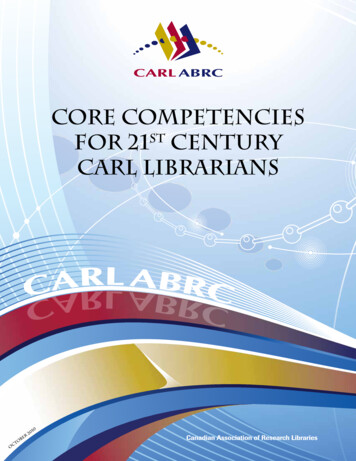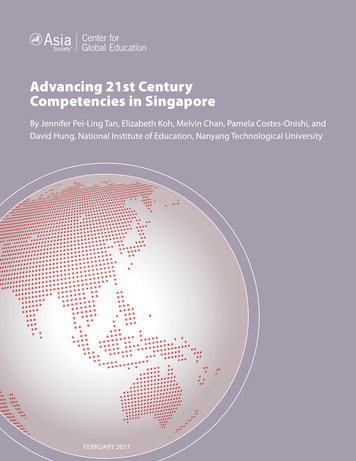
Transcription
Advancing 21st CenturyCompetencies in SingaporeBy Jennifer Pei-Ling Tan, Elizabeth Koh, Melvin Chan, Pamela Costes-Onishi, andDavid Hung, National Institute of Education, Nanyang Technological UniversityFEBRUARY 2017
Advancing 21st Century Competenciesin SingaporeFebruary 2017Case Study Authors:Jennifer Pei-Ling Tan, Elizabeth Koh, Melvin Chan, Pamela Costes-Onishi, and David Hung,National Institute of Education, Nanyang Technological University
ASIA SOCIETYAsia Society is the leading educational organization dedicated to promoting mutual understanding andstrengthening partnerships among peoples, leaders, and institutions of Asia and the United States in a globalcontext. Founded in 1956 by John D. Rockefeller 3rd, Asia Society today is a global institution—withoffices throughout the United States and Asia—that fulfills its educational mandate through a wide rangeof cross-disciplinary programming. Across the fields of arts, business, culture, education, and policy, theSociety provides insight, generates ideas, and promotes collaboration to address present challenges and createa shared future.The Center for Global Education at Asia Society brings together leaders and institutions from aroundthe world to tackle one of the most critical education challenges today: how to educate all students foremployability and citizenship in a global era. Our mission is to develop global competence in students,young leaders, and educators as the foundation for understanding between people in the Asia Pacific regionand throughout the world. We accomplish this by working with educators, school districts, parents, andcommunities to ensure that they have the tools and support they need to globalize learning and prepareyoung people for our global future.ACKNOWLEDGMENTSThis paper is one of five case studies that accompany the Asia Society report entitled “Advancing 21st CenturyCompetencies in East Asian Education Systems” by Professor Kai-ming Cheng from the University of HongKong. Professor Cheng assembled and led an international team of researchers who developed the case studyreports on each country. We are grateful for the contributions of Kai-ming Cheng and Liz Jackson fromthe University of Hong Kong; Wing-on Lee from The Open University of Hong Kong; Daisuke Kimuraand Madoka Tatsuno from Global Incubation x Fostering Talents (GiFT) in Japan; Jennifer Pei-Ling Tan,Elizabeth Koh, David Hung, Melvin Chan, and Pamela Onishi from the National Institute of Education atNanyang Technological University in Singapore; Hyo-Jeong Kim and Jeongmin Eom from the Asia-PacificCentre of Education for International Understanding (APCEIU) in South Korea; and Hsiao-Lan SharonChen and Hsuan-Yi Huang from the National Taiwan Normal University in Taiwan.At Asia Society, Alexis Menten directed the conception, development, and publication of the paper, incollaboration with the authors. We wish to thank Asia Society Senior Advisor Vivien Stewart for her invaluableguidance throughout the development of this paper.This paper was informed by teams participating in Asia Society’s Global Cities Education Network 21stcentury competencies working group, including Hiroshima, Japan; Seoul, South Korea; and Singapore.Several Asia Society staff contributed to the development and support of this paper and the 21st centurycompetencies working group, including Tony Jackson, Alexis Menten, Jessica Kehayes, Heather Loewecke,Heather Singmaster, and Apoorvaa Joshi.We thank the William and Flora Hewlett Foundation for its support of the development, publication, anddissemination of this paper.i
TABLE OF CONTENTSChapter 1: Educating for 21st Century Competencies (21CC):The Singapore Journey. 1–16Introduction. 1–2The “Little Red Dot”. 1Beating the Odds?. 2Two Decades of 21CC Education Initiatives and Policies (119–2016). 3–8Thinking Schools, Learning Nation: A Pivotal 21CC Vision. 3Table 1: Key Highlights of 21CC-related Policies and Initiatives inSingapore (1997–2015). 4Teach Less, Learn More. 6Framework for 21CC and Student Outcomes. 6A Systemic Ecological Approach to Educational Change. 8Strong Tripartite Relationship A Key Enabling Mechanism for21CC Education in Singapore. 8–9NIE a Key Node in the Tripartite Network: Strategic Alignmentsin Teacher Education and Research to Further the 21CCEducational Agenda. 9–15Teacher Education Model for the 21st Century (TE21). 10ER3.0: A Responsive Education Research Agenda 10 Years on. 11Chapter Summary. 15Chapter 2: Educating for 21CC in Singapore: From Policy to Practice. 17–24Introduction. 17Educating for 21CC in Singapore: Highlights of Policy toPractice Enactments. 17–23Structural Shifts. 17Programmatic Shifts. 19Programe of Active Learning, PE, Arts, and MusicEducation (PALPAM). 19Applied Learning and Learning for Life Programmes (ALP/LLP). 20ALP and LLP in the Arts. 20Socio-Technological Infrastructural Shifts. 21Concluding Remarks. 23–24References. 25–28ii
Chapter 1:Educating for 21st Century Competencies (21CC):The Singapore JourneyBy Jennifer Pei-Ling Tan, Elizabeth Koh, and David Hung, National Institute of Education,Nanyang Technological UniversityINTRODUCTIONIn this chapter, we make an attempt to broadly chronicle the key educational aspirations, policy thrusts,and reform initiatives that we consider to be noteworthy in Singapore’s journey toward preparing our youngpeople for the 21st century. These were collectively aimed at forging a resilient and active national citizenrycharacterized by strong shared values of social responsibility, respect, and harmony amid diversity, alongsidehigh levels of 21st century workforce-relevant knowledge and competencies vital to our young nation-state’ssustained productivity and growth in the wider global economy. The aim here is to provide some insights intowhen and how “21st century competencies” (21CC) was conceived, articulated, and enacted in Singapore’spublic education discourse, policy, and practice. We then highlight one particular “enabling mechanism”—thatof a strong tripartite relationship among Singapore’s educational critical stakeholder groups in policy, research,and practice—held together by a common vision and mission that have underpinned, and we expect willcontinue to buttress, Singapore’s ongoing educational innovation and success in the years ahead.We qualify at the outset that this chapter represents only one local narrative of the pivotal ways in whichSingapore’s formal education sector has engaged with and responded to the global 21CC agenda over the pasttwo decades. It is by no means intended as an official historical account that reflects the unanimous viewsand/or institutional stances of the National Institute of Education and the Ministry of Education (MOE)Singapore. While the authors draw from and make reference to a number of published sources, includinggovernment press releases, policy and curricular documents, as well as relevant academic publications, thischapter nevertheless constitutes a reflective and synthetic narrative of the key educational aspirations and effortsundertaken in Singapore, as seen through the lived experiences of three Singaporean educational researchers andteacher-educators—who once studied in and now work within the system—and who bear a shared professionaldedication to Singapore’s ongoing commitment to providing high-quality and future-relevant educationalexperiences, outcomes, and social trajectories for its young people.THE “LITTLE RED DOT”Singapore is often referred to, mostly affectionately, in the media and in conversations as the “Little Red Dot.”This nickname is both a literal reference to the way it is visualized on many world maps, as well as a figurativereference to its physical size, especially when taken in contrast to its achievements. Singapore has been thesubject of some level of “international fascination partly because [it] is so small and yet so well-knownand influential and partly because of its extraordinary success,” both economically, as well as “in internationalcomparative student achievement tests” (Connelly, 2013, pp. vii).For a young postcolonial island city-state that was barely 582 square kilometers with neither hinterlandnor natural resources when it gained independence in the mid-1960s, few would refute that it has achievedremarkable economic success and established a robust internationally recognized education system within1
a generation. Today, Singapore’s reported land area of 719 square kilometers is densely populated with anestimated population of 5.5 million comprising both local and foreign-born citizens (61%) and permanentresidents or temporary migrants on study/work/dependent status (39%) of diverse ethnic, linguistic, andreligious backgrounds (Department of Statistics Singapore, 2016). Its cataloged achievements and accolades arenumerous, some more commonly known, while others can still invoke some element of surprise when broughtto the fore. We highlight some notable examples here. Singapore: i s a global leader in several economic sectors, including the world’s top logistics hub and largest oil-rigproducer, 3rd-largest oil-refining and trading center and major hub for ship repair services, 3rd-largestforeign exchange center, and 4th-leading financial center; r anks as 2nd-freest economy in the world per the 2015 Index of Economic Freedom, and consistentlyranks as one of the least corrupt countries in the world per the Corruption Perception Index, beingthe only Asian country in the past decade to receive the top-tier AAA sovereign ratings from all majorcredit rating agencies worldwide; c onsistently reports one of the lowest unemployment rates among developed countries, while itshighly developed market economy—historically founded on extended entrepôt trade—reports aremarkable GDP per capita of approximately SGD71,000 or USD49,000 (Department of StatisticsSingapore, 2015); r anks as the most “Technology-Ready Nation” by the World Economic Forum in its 2015 GlobalTechnology Report; r anks 1st in Asia and 11th worldwide in terms of its national social policies as indicated by the UN’sHuman Development Index that draws on key measures of education, health care, life expectancy,quality of life, personal safety, and housing; r anks as the 6th-best health care system in the world per the World Health Organization’s WorldHealth Report, with life expectancy rates ranked 4th in the world; r anks 4th worldwide in the 2014 Environmental Performance Index, which measures the effectivenessof state policies for environmental sustainability (Yale Center for Environmental Law & Policy, 2014); r anks as the 1st- and 6th-best world destination to visit in 2015 by Lonely Planet and the New YorkTimes, respectively; and i s a major education hub attracting more than 80,000 international students in 2006, a figure that hasmore or less remained steady despite slight fluctuations in the past decade (EU-Asia Higher EducationPlatform, 2011); while its two most established local universities continue to steadily climb the worlduniversity rankings in recent years, with the National University of Singapore ranked 26th worldwide,and Nanyang Technological University ranked 55th and 10th worldwide, overall and in the field ofeducation, respectively (Quacquarelli Symonds Limited, 2015).BEATING THE ODDS?Against this background, “beating the odds” is a commonly heard idiom when Singapore is spoken of. Thissuggests that many view the Singapore story and trajectory as one that has defied “commonsensical,” even logicaland calculated, probabilities of success.2
In a similar vein, we argue that the Singapore education landscape defies simplistic stereotypes. On the one hand,many are quick to attribute its consistent strong performance in international benchmarking studies, such asthe Programme for International Student Assessment (PISA) and the Trends in International Mathematics andScience Study (TIMSS), to a highly structured, teacher-centric, and content-focused system. Alongside thesecritiques are largely unsubstantiated claims that such an education system tends to produce students who may dowell in memorizing and reproducing factual content, and be prolific at providing accurate answers to structuredexam questions, but who are weak in exercising creative and critical faculties in a flexible manner to solve illdefined, complex problems. Yet, results of the 2012 PISA assessment of students’ creative problem-solving abilitiesserved to confound clichéd understandings of Singapore’s public education terrain, when its 15-year-olds againoutperformed many of their international peers on tasks that required flexible and innovative thinking, and thetransfer and application of learning to unfamiliar and complex problem contexts.Our interest here is to push beyond simple binary formulations and broad generalizations of Singapore’s educationsystem. We do so by taking a closer look in the next section at the various educational initiatives over the past twodecades that reflect a purposeful drive to nurture a resilient, agile, and productive social citizenry who can not onlysurvive but thrive in the 21st century, characterized by rapid technological advancements and heightened globalcompetitiveness and vulnerabilities.TWO DECADES OF 21CC EDUCATION INITIATIVES AND POLICIES(1997–2016)THINKING SCHOOLS, LEARNING NATION: A PIVOTAL 21CC VISIONFacing rapid globalization, the knowledge-based economy, and increasing global competition, the Ministry ofEducation undertook a major curriculum review in 1997 to rethink its goals and directions for the future (MOE,2008; Poon et al., in press). This led to the inception of Thinking Schools, Learning Nation (TSLN) in the sameyear. TSLN was a pivotal policy shift toward 21CC education that aimed to prepare Singapore’s students for thefuture. It represented a clear articulation that the future sustainability and economic growth of Singapore dependedon the ability of its people to learn (Goh & Gopinathan, 2008), and consequently, that transformation of pedagogyand practice in schools and classrooms was needed to broaden learning experiences and better address students’diverse learning needs (Poon et al., in press). While there had been several curricular programs introduced priorto 1997 that focused on enhancing students’ thinking skills (Deng, Gopinathan, & Lee, 2013), the 1997 launchof TSLN is widely recognized as a defining moment that formalized Singapore’s systemic efforts in educatingfor 21CC that concentrated resources on teachers, infrastructure, and technology, with the aim of developing instudents the necessary knowledge and competencies to respond to challenges ahead. In this way, TSLN firmlycemented Singapore’s move into educating for 21CC (Poon et al., in press). The policy focused on enablingstudents to develop creative and critical thinking skills, and its strategies included the explicit teaching of creativeand critical thinking skills, reduction of curriculum content, revision of assessment modes, and greater emphasison process instead of outcomes in learning and teaching (MOE, 1997b; Tan, 2013).Following the TSLN vision, a suite of 21CC curriculum initiatives were systematically introduced and refined tostrengthen the preparation of Singapore’s young people for the future. Table 1 provides a list of some of the keyinitiatives that were implemented over the past two decades. These included changes to curriculum and pedagogies,infrastructure and technology support, and programs and structures, which are briefly explained in the followingsection. Poon et al. (in press) conceptualized this as a systems approach to realizing the TSLN, which required a3
common vision and belief, a culture of continuous improvement, an open and collaborative school environment,and Ministry support.Table 1: Key Highlights of 21CC-related Policies and Initiatives in Singapore(1997–2015)Policy/InitiativeTenBrief Description1997Thinking Schools, LearningNation (TSLN)Launched by then-Prime Minister Goh Chok Tong, TSLN was a vision toprepare students to meet the challenges of the future (MOE, 1997b).1997First Masterplan for ICT inEducation (Masterplan 1)Masterplan 1 was launched by Teo Chee Hean, then-Minister forEducation. It aimed to equip each school with hardware, software, andnetwork connectivity for students and teachers to access resources.It also targeted that 30% of students’ curriculum time would usecomputers (MOE, 1997c).1997National EducationCurriculumLaunched by then-Deputy Prime Minister Lee Hsien Loong to developnational cohesion by instilling shared core values, the will to prevail, andensure Singapore’s continued success and well-being (MOE, 1997a).1997Desired Outcomes ofEducationFirst formulated by MOE in 1997, it envisioned what the Singaporestudent should attain (MOE, 2009a).2003Second Masterplan for ICT inEducation (Masterplan 2)This built on Masterplan 1 and aimed for the effective and pervasive useof ICT in schools by integrating ICT into the curriculum, establishingbaseline ICT standards, and seeding innovative use of ICT amongschools (MOE, 2015a).2004Integrated ProgrammeProvided some students with broader learning experiences througha seamless six-year program starting in grade 7 (Secondary 1) thatculminates in a grade 12 (Pre-Tertiary 2) examination, without having tosit for a grade 10 (Secondary 4) GCE “O” levels national examination.2004Direct School AdmissionschemeOffered students the opportunity to gain admission to secondaryschooling based on specialized strengths rather than solely on academicgrades (Tan, Chow, & Goh, 2008).2005Teach Less, Learn More(TLLM)Emphasized pedagogical change to encourage active and independentlearning by trimming syllabus content and to enhance critical thinkingand inquiry-based learning among students.2006Revised Junior CollegeCurriculumOffered greater breadth and depth of learning as students study at leastone subject beyond their main specialization and have the choice ofdiffering levels of study within each subject (MOE, 2002).2009Third Masterplan for ICT inEducation (Masterplan 3)Masterplan 3 built on previous masterplans and aimed to develop students’self-directed and collaborative learning using ICT (MOE, 2015b).2009Revised Desired Outcomes ofEducationThe first set of Desired Outcomes of Education in 1997 was re-articulatedinto four specific Desired Outcomes of Education—namely, ConfidentPerson, Self-Directed Learner, Active Contributor, Concerned Citizen.201021CC FrameworkA “total curriculum” framework that articulated Singapore’s educationvision where the four Desired Outcomes of Education are underpinnedby a suite of emerging 21CC, social-emotional competencies, and values(see Figure 1).Year4
Year2010Policy/InitiativeTenBrief DescriptionPrimary and SecondaryEducation Review andImplementation(PERI and SERI)The PERI committee was formed to evaluate and improve the quality ofprimary education in Singapore, including social-emotional development,non-academic curriculum, and lifelong learning (MOE, 2009b). Keyinitiatives included Holistic Assessment; Programme for Active Learning;PE, Art, and Music Education; Engaging Pedagogies; Strategies toEnsure More Attention for Individual Pupil Development; and enhancinginfrastructure and investing in a quality teaching force.The SERI committee was the equivalent of their PERI counterpart toenhance the quality of secondary education in Singapore.2012Teacher Growth ModelA professional development model to encourage teachers’ lifelonglearning and personal well-being (MOE, 2012).2012Values in Action (VIA)Learning experiences that encourage students’ involvement in thecommunity and nurture them to become socially responsible citizens.2013Applied Learning Programme(ALP) and Learning for LifeProgramme (LLP)To be started in all schools by 2017, the ALP focuses oninterdisciplinary knowledge and the application of skills to professionalreal-world settings; the LLP aims to nurture students’ character andvalues, and develop their interpersonal skill (MOE, n.d.).2015Fourth Masterplan for ICT inEducation (Masterplan 4)The goal of MP4 is to develop future-ready and responsible digitallearners. It is aligned with student-centric and values-driven educationand aims to help students develop mastery of subjects and enhancetheir 21CC (MOE, 2015c).In the years closely following 1997, tied to the push for students in Singapore schools to learn more effectivelyin acquiring both content knowledge and 21CC, technology was (and continues to be) considered a powerfulleverage. The Masterplan 1 (MP1) for Information Communication Technology (ICT) in Education waslaunched in 1997. It aimed to encourage students to acquire thinking, learning, and communicating skillsthrough harnessing the use of IT. MP1 also helped equip schools with the necessary hardware and software(e.g., computers, printers, Internet, CD-ROM, word processor) to enable learning and teaching with thesetools. MP1’s target was to have all schools equipped with the necessary technological infrastructure for IT-basedlearning for up to 30% of the curriculum (MOE, 1997c).The National Education initiative was also launched in 1997 to nurture national cohesion and inculcate ashared national identity among students. It aimed to help students recognize the vulnerabilities and challengesthat Singapore faced, and its core values were meritocracy, multiracial harmony, and multireligious harmony.Besides an awareness of Singapore’s challenges, a key initiative rolled out during this same period was the DesiredOutcomes of Education. This aimed to develop the Singapore student in the moral, cognitive, physical, social,and aesthetic aspects. Intermediate and final outcomes for primary, secondary, junior college, and postsecondaryand tertiary education were set. These included goals such as being morally upright, believing in principles ofmultiracialism and meritocracy, being gracious, willing to strive, think, and reason, seeking knowledge, andbeing innovative (Tan, 2013). These would later be refined and re-articulated in 2009.The driving premise behind these 21CC-related initiatives implemented in the early years following 1997 wasaptly summarized by the then-Minister of Education Teo Chee Hean (MOE, 1999):The Desired Outcomes define our goals in education. We aim to achieve these outcomes through variousinitiatives—the ICT Masterplan, National Education, the Curriculum Review. All these aim to develop our5
young for life, not just for their schooling days; and to develop their potential to the full, not just in academicstudies. This requires our Education system to shift from an efficiency-driven to an ability-driven paradigm.Teach Less, Learn MoreThe emphasis of pedagogical change was a key thrust from TSLN. In 2004, the “Teach Less, Learn More”(TLLM) movement further enabled the realization of pedagogical change set out in the TSLN vision. TLLMwas first introduced by Prime Minister Lee Hsien Loong in 2004 and subsequently launched in 2005 by thenMinister of Education Tharman Shanmugaratnam with the aim of enhancing the quality of education throughreducing syllabuses so that students have more space to learn and explore (Koh, 2013; MOE, 2005). Thisdevelopment was premised on the recognition that 21CC education required new innovative pedagogies suchas inquiry-based learning, which requires more curriculum time. The operationalization of TLLM in practicewas supported by a suite of curriculum frameworks and resources with practical principles that aimed to helpteachers put the TLLM ideas into practice more easily. These included the TLLM framework, the TLLM Ignite!package, and the PETALSTM framework, among others (Teo, Deng, Lee, & Lim-Ratnam, 2013).The technology aspect was also refined in that there was a push for greater integration between 21CC learningand technology. The aim of the Third Masterplan for ICT (MP3) launched in 2009 was to “enrich andtransform the learning environments” and equip students “with the critical competencies and dispositions tosucceed in a knowledge economy” (MOE, 2015b). Two key 21CCs were emphasized: self-directed learningand collaborative learning competencies. Many ICT innovations in learning and teaching were spearheaded byschools and curriculum planners in the Ministry to do so.In the same year of MP3, the desired outcomes of education were revised. Based on the continuing feedbackand reviews from various stakeholders, MOE synthesized the earlier articulations into four desired outcomesof the student (MOE, 2009a): a confident person who has a strong sense of right and wrong, is adaptable and resilient, knowshimself, is discerning in judgment, thinks independently and critically, and communicates effectively; a self-directed learner who takes responsibility for his own learning, who questions, reflects, andperseveres in the pursuit of learning; a n active contributor who can work effectively in teams, exercises initiative, takes calculated risks, isinnovative, and strives for excellence; and a concerned citizen who is rooted to Singapore, has a strong civic consciousness, is informed, andtakes an active role in bettering the lives of others around him.These revised desired outcomes also emphasized students’ development of self-awareness, and interpersonalrelationships, and served as a vision that continues to guide the Ministry in all its educational and curricularpolicies and initiatives.Framework for 21CC and Student OutcomesClosely following the revised desired outcomes in 2009, the Framework for 21CC and Student Outcomes (Figure1) formalized in 2010 represented one of the most significant developments in Singapore’s 21CC education efforts6
in recent years (MOE, 2016a; Tan, 2013). Broadening the earlier focus on thinking skills, the framework expanded21CC to include values, emotions, interpersonal skills, and emerging forms of 21CC (Poon et al., in press).Affectionately called the “swiss-roll,” the framework is depicted as three concentric layers. The outer layerconsists of three broad areas of emerging 21CC: Civic Literacy, Global Awareness, and Cross-Cultural Skills(CGC), Critical and Inventive Thinking (CIT), and Communication, Collaboration, and Information Skills(CCI). The term “emerging 21CC” was used, as these competencies were recognized as becoming increasinglyvital to helping Singapore’s young people thrive in the 21st century. The inner layer represents the social andemotional competencies—Self-Awareness, Self-Management, Social Awareness, Relationship Management,and Responsible Decision-Making—that are viewed as enablers to the acquisition of the emerging 21CC. At theheart of the framework sit the core values of Respect, Responsibility, Integrity, Care, Resilience, and Harmony,which together anchor the development of competencies.Figure 1: Framework for 21CC and Student OutcomesSince its inception, the 21CC framework has been infused into the academic curriculum, co-curricular activities,character and citizenship education, as well as applied learning programs (for secondary schools). Toh, Hung,Chua, He, and Jamaludin (in press) highlighted that this integration avoids the trap of compartmentalizationand affords the sustainability of these competencies in the Singapore education system.In 2011, value-centric and need-based strategies and policies were emphasized. This was signaled by the thenMinister of Education Heng Swee Kiat in 2011. Heng (MOE, 2011) launched the Character and CitizenshipEducation (CCE) framework, which brought together National Education (NE), Values Education, Educationand Career Guidance, as well as Cyberwellness and Sexuality Education. This was based on ground-up feedbackfrom numerous stakeholders in the education system. Heng (MOE, 2011, p. 5) posited:We want to make our education system even more student-centric, and sharpen our focus in holistic education—centred on values and character development. We could call this Student-Centric, Values-Driven education.Another way of putting it, value in our learners and learning values.As a case in point, the Community Involvement Programme, which builds 21CC and character, was repositionedas Values in Action in 2012. This emphasized the character-building aspect of the program. In 2013, theinitiative of having two distinctive student-centric and ho
people for the 21st century. These were collectively aimed at forging a resilient and active national citizenry characterized by strong shared values of social responsibility, respect, and harmony amid diversity, alongside high levels of 21st century workforce-relevant knowledge and competencies vital to our young nation-state's
